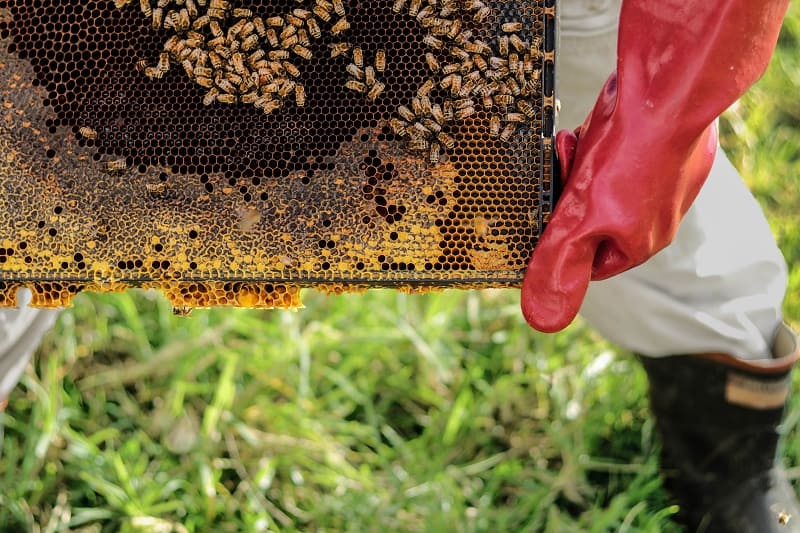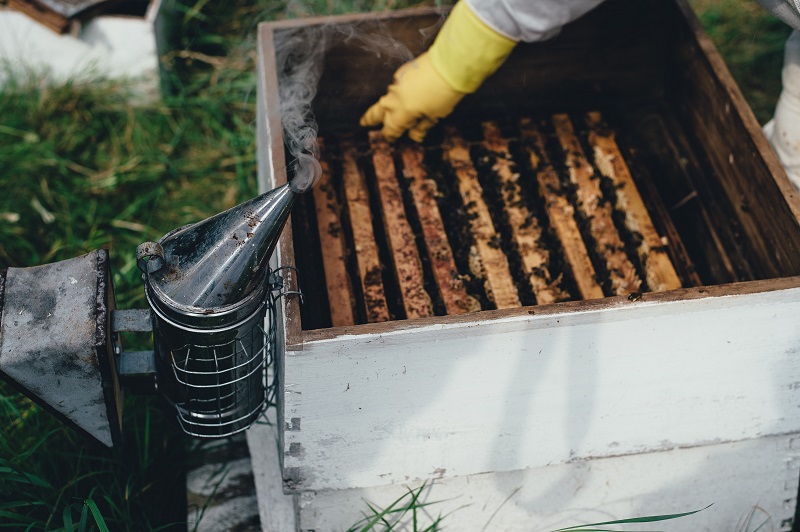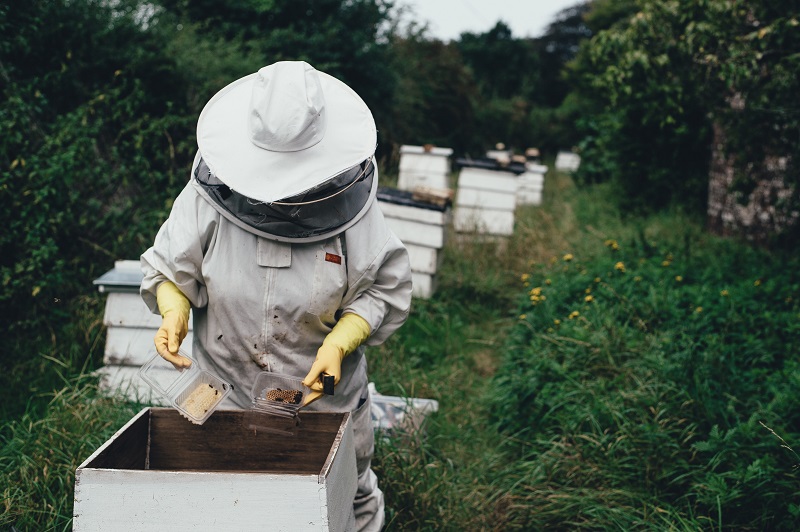Becoming a beekeeper is a challenging yet rewarding experience. With an increase in demand for natural household goods, homeowners across the U.S continue to pursue beekeeping for natural alternatives. Whether your beekeeping is a profession or hobby, you can do it in your own backyard.
An ancestor of wasps and ants, the bee is a prehistoric insect that has evolved and divided into approximately 30,000 different species over the years. The first beehives kept by people were called skeps. The problem was that extracting the honey destroyed the skeps. Lorenzo Langstroth developed a new system that is similar to what is used now.
The Pilgrims brought honeybees to North America in order to have beeswax and honey. These bees live in a hive that can produce up to 100,000 bees that not only provide honey and beeswax but also pollinate flowers, vegetables, and fruits.

The Benefits of Beekeeping and Conservation
While many people associate the word “bee” with getting stung, these insects are essential to human life on this earth. They pollinate the crops and initiate the reproduction of many plants as they move pollen from stamens to pistils. Unfortunately, the pesticides used on crops can either kill bees or render them incapable of doing the job we depend on for our food.
Even though states like California are still able to produce 13,000 pounds of honey each year, there are several issues impacting the decreasing the bee population. Environmental concerns, such as pollution, can be a serious detriment to an entire colony of bees. Another danger to the bee population are parasites that can maim or kill both young and adult bees.
Improving the longevity of the bee population isn’t the only benefit of beekeeping. Here are a few additional advantages:
- Pollination – improves the biodiversity of the environment for more bountiful gardens, prosperous orchards, and allergy remedies
- Honey – often referred to as “liquid gold”, honey offers many health and wellness benefits such as rich antioxidants, antibacterial properties, and natural sweetening capabilities
- Beeswax – not only is beeswax highly beeswax highly moisturizing, but it can also be used around the house for natural alternatives to deodorant, candles, baby products, and hinge lubrication.
Now that you know why you should pursue beekeeping, here are five steps to get started:
1. Check Local Beekeeping Laws and Regulations
Research what is required before you take another step toward becoming a beekeeper. Here are a few things to look into:
- Find out whether or not your location allows it and if you are required to get a permit.
- Check if your county or city requires registration for beehives.
- There may be some land requirements that you’ll have to meet before you can move forward with beekeeping.
2. Find the Ideal Beekeeping Location
You’ll need to consider your location and whether or not it is conducive to beekeeping. Bees need hives that get plenty of sun and shelter from high winds. During the winter, you’ll need to have easy access so you can clear the snow away from the hive entrances.
If there are other houses nearby, check with other folks in the neighborhood to make sure you don’t cause a problem. You don’t want to become a nuisance to families with small children who play outdoors or seniors who may have a bad reaction to a couple of bee stings. If you live in a neighborhood, you may want to offer some bee education to the people around you.
3. Gather Your Beekeeping Supplies
Some of the basic items you need include:
- Bee suit with a veil
- A smoker that calms bees and enables you to get into the hive
- Hive tool to pry off the frames
- Uncapping knife for cutting wax off the frame of honey
- Honey extractor to collect your “liquid gold”
- Bee gloves to protect your hands and the bees
- Brush to swipe the bees off the comb
You’ll also need to purchase at least one hive, but many bee experts recommend starting with two hives. And of course, you’ll need some bee swarms. Since you don’t want your hives on the ground, you should get a hive stand to keep the bees off the ground and protect them from other insects.
Purchase your beekeeping supplies from a reputable dealer. Some of the places you can look include the Home Depot, Tractor Supply Company, Bailey Bee Supply, and Western Bee Supplies.

4. Get the Proper Beekeeping Protection
Protecting yourself is essential if you want to be a beekeeper. You may choose a beekeeper’s suit when you first get started and wear it until you become more comfortable as you get to know your bees. Bees can sense fear and tension, and they’re likelier to sting if they feel that they’re in danger. You still might get stung, so you may want to invest in an EpiPen if you’re concerned about a possible allergic reaction.
Even if you choose not to wear full protective gear, make sure you wear a veil. A bee sting to the eye can produce long-term swelling and may possibly cause permanent vision loss. Stings on the lips or other parts of the face can be excruciating. There are different styles of veils and hoods, so choose the one that is most comfortable for you.
5. Build Your Beehive
Many people prefer to purchase ready-made beehives when they first get started. However, you may want to save some money and build your own.
Start with any type of solid wood that doesn’t have cracks. You’ll need these items to get started:
- Hammer
- Nails
- Clamps
- Non-toxic wood glue
- Exterior paint
- Paintbrush
You can build one without the glue, but it provides a better seal, so it’s recommended.
The ideal beehive is a box built from finger-jointed wooden pieces. However, you can also use flat-edged wood, as long as you can create a square box that is secure and sealed. If you choose to use wood glue, apply that before nailing the box, making sure the handle is on the outside and easily accessible. You’ll want to paint the hive with exterior paint to prevent the wood from rotting.

Maintaining and Benefiting from Your Beehive
As a beekeeper, you have ready access to honey and beeswax for a variety of uses. Honey is not only a delicious way to sweeten foods it provides some protection from allergies. Many people use honey to suppress coughs, and it’s delicious on peanut butter sandwiches. Substitute honey for sugar in some of your recipes for a deeper, richer flavor.
You can use beeswax in a vast number of ways. Some of the personal uses include lip balm and skin moisturizers. Mix it with chickweed powder, comfrey powder, and olive oil for itch relief.
There are also quite a few things you can do with beeswax around the house. Rub a little of it on the rails of a stuck drawer, and you’ll be able to open and close it with no problem. Wax your wooden furniture and exposed beams with beeswax. You can also lubricate screws, nuts, and bolts with it. Before exposing leather shoes or handbags to the elements, rub a little beeswax on them for protection.
What If I have to Move My Beehive?
As a dedicated beekeeper, you may have to move the hive if you are relocating or the natural environment surrounding the hive is no longer ideal. The idea of moving a beehive can be intimidating for newer beekeepers but can be accomplished under the right conditions.
Historically, most advanced beekeepers believe that if you can only move your hive “3 feet or 3 miles.” If you stay within the three-foot radius, the colony will be able to reorientate on their own. On the other hand, three miles is enough for the colony to recognize the new location of their home.
Don’t fret though – transferring a beehive can be done in a few simple steps.
- Wait until dusk to ensure the colony is back from their daily worker bee routines. It’s important to get started before it’s too dark to have proper visibility.
- Tape the front of the beehive with breathable material such as screen wire or tulle.
- Carefully lift the beehive, trying to remain as level as possible, and walk to the new location or the vehicle for transport.
- Place the hive in the new location.
- Wait fifteen minutes before opening the block to give the colony time to reorientate.
Keeping Your Bees Healthy
If you want your bees to continue producing honey and beeswax, you need to take care of them. Here are a few final tips to keep your hive buzzing:
- The hives and beekeeping supplies need to be clean and well maintained.
- Only purchase the bees from reputable people who check for diseases and pests.
- Clean your equipment on a regular schedule to prevent fungus.
- Change out the queen every couple of years with a young, healthy queen bee.
Have you had success with backyard beekeeping? Let us know in the comments below!
This post first appeared on Redfin.com. To see the original, click here.
